San Diego State is following a growing trend to hire more part-time faculty than tenure-track professors to cut costs.
The California State University system has seen an increase in the hiring of part-time faculty at its 23 campuses to stay within its budget. SDSU has been a steady increase in the percentage of part-time faculty from 31.9 percent in the fall 2010 to 38 percent in fall 2014.
“The way the ratio is figured out is based on not specifically head count, but how much people teach,” Associate Vice President for Faculty Affairs Edith Benkov said. “Because we had not been hiring as many tenure-track faculty the past few years, the tenure-track faculty population decreased and because of that, the part time and temporary faculty proportion goes up.”
Tenure-track faculty formed 61 percent of total faculty population at SDSU in fall 2014, down from 67 percent in fall 2012.
Because of strict budget cuts in California, rather than hiring new tenure-track staff, part time faculty were brought in as a way to conserve money.
“With temporary faculty the funding is much more fluid because you’re not making any type of specific commitment to them,” Benkov said. “Also most temporary faculty do not have the Ph.D.s, so their salary is lower.”
Because faculty that are not tenure-track generally make less money than those staff members who have a Ph.D., many work at more than just one school in order to supplement their income.
Leslie Bryan, a lecturer representative for Southern California, said it is hard to be as involved on campus as a lecturer because of a lack of time.
“I think that one of the bigger hurdles is that most of the lecturers I know — even the ones that are full time — tend to make less money, so we have to work at other places and do other things,” Bryan said.
University service is part of the contract for all tenure-track staff, such as advising, curricular development and positions on different types of committees.
Part-time faculty members tend to teach fewer classes, are more likely to work at more than one college, and do not partake in university service.
“That’s another issue because if you have a small department you may have four or five tenure-track faculty and you could have ten or fifteen lecturers but the lecturers can’t participate in a lot of the main university business,” Benkov said
In addition, there are committees that by definition part-time faculty may not be involved in.
“It’s interesting because on most campuses there are more lectures than tenure-staff and yet we are not part of that governing body,” Bryan said. “Even though lecturers have the desire and the passion, they are not allowed to do that.”
The Sacramento Bee reported there is a lack of teachers to offer sections for required courses at California State University, Sacramento.
Benkov, however, does not believe this is a major problem at SDSU.
“Even at the upper-division level we will add a course if it is necessary,” Benkov said. “We have raised the cap on many courses just to make up for the fact that we don’t have as many classes.”
Benkov said the ideal tenure-track to part-time faculty would be 75 percent to 25 percent, respectively.
“With tenure-track faculty you have more people who are fully committed to the university because that is their job,” Benkov said. “It is not a blanket statement to say it is bad having temporary faculty. Some of them have taught here 30 years.”
Bryan has taught at California State University, San Bernardino for the past 17 years as a part-time staff member.
“When you have the passion to teach you usually do want to give something to your community and so a lot of lectures have that same passion,” Bryan said. “It is a big body of knowledge coming from a very dedicated group of people that need to be allowed to be more involved in what is happening on their campuses and the decisions being made.”







